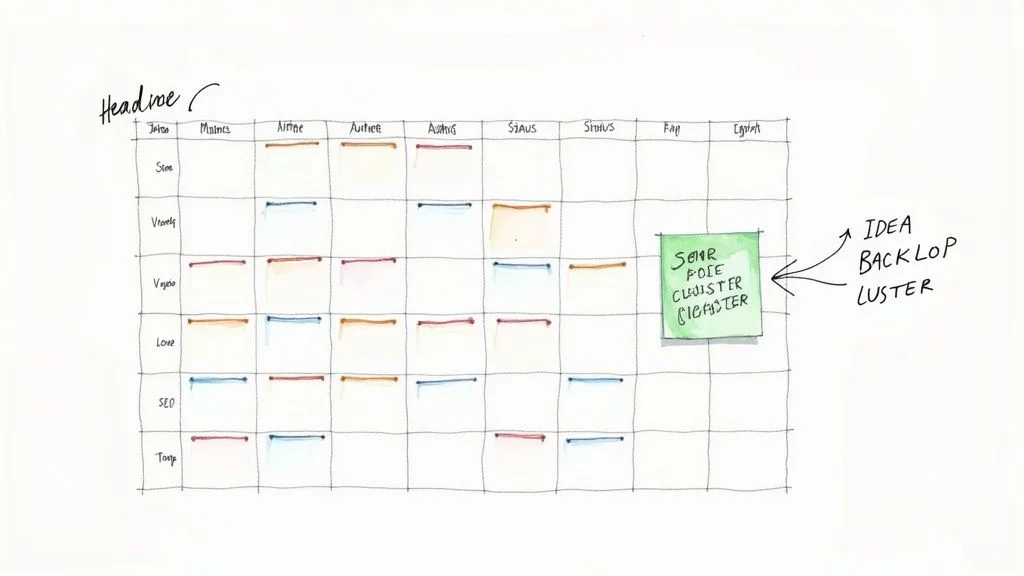
How to Create a Content Calendar that Drives Growth
Sections
Let’s be honest, trying to run a content strategy without a content calendar is like trying to build a house without a blueprint. Sure, you might get a wall up here and there, but you’ll end up with a chaotic mess that doesn’t serve any real purpose. A proper content calendar is what turns random acts of content creation into a focused, predictable engine for growth. It’s the roadmap ensuring every single piece you publish has a purpose and a plan.
#Why a Content Calendar Is Your Strategic North Star

Before we jump into templates and tools, let’s get clear on why a content calendar is completely non-negotiable for any serious marketer. It’s so much more than just a schedule of blog posts. Think of it as the strategic command center for your entire content marketing operation.
Without a documented plan, most teams fall into a state of reactive chaos. We’ve all been there: scrambling for a last-minute topic on a Friday afternoon or pushing out content that has zero connection to any real business goal. That approach doesn’t just waste time and money; it completely fails to build any kind of momentum.
#Fostering Consistency and Collaboration
A good calendar brings predictability and consistency to the table - two things that are absolutely critical for building an audience and getting love from Google. When your readers know they can expect valuable stuff from you on a regular basis, they’ll keep coming back. Search engines also tend to reward websites that publish fresh, relevant content on a consistent schedule.
On top of that, it becomes the central source of truth for your entire team. Writers, designers, SEO specialists, and social media managers can all see what’s in the pipeline, understand deadlines, and align their work without needing endless back-and-forth meetings.
#The Power of a Documented Strategy
The gap between successful content programs and struggling ones often boils down to a single thing: a documented strategy. The data doesn’t lie. A staggering 47% of B2B content marketers who feel successful attribute it to having a written content strategy, which is exactly what a calendar brings to life.
And with 93% of B2B marketers using content marketing, having that structured plan is what separates the top performers from everyone else just making noise. If you want to dive deeper, you can find more insights about content marketing effectiveness from recent studies.
A great content calendar doesn’t just tell you what to post and when. It forces you to answer why you’re creating each piece of content, ensuring every article, video, and social update serves a larger business goal.
Ultimately, understanding why you need a calendar is the first real step toward building one that actually works. It shifts your mindset from just filling empty slots on a spreadsheet to strategically mapping out a journey for your audience, guiding them from awareness all the way to conversion. Get this foundation right before you even start thinking about how to build a content calendar that’s perfect for your team.
#Laying the Strategic Groundwork First

I get it. You’re eager to start filling in those calendar slots with brilliant blog post ideas. But hold on a second. Jumping straight into a template without a solid game plan is like trying to build a house without a blueprint. You’ll just end up with a random pile of content that doesn’t actually do anything for your business.
To build a content calendar that works, you have to lay the foundation first. This prep work ensures every single piece of content you create has a clear, strategic purpose.
#What’s the Point? Define Your Content Goals
First things first, what are you actually trying to achieve? Vague goals like “get more traffic” are useless. You need to get specific and tie your content efforts directly to real business outcomes.
Are you aiming to increase organic search traffic by 20% in the next quarter? Or maybe you’re focused on generating 50 new Sales Qualified Leads (SQLs) every month? Perhaps the real goal is to support existing customers by reducing support tickets with helpful tutorials.
Setting S.M.A.R.T. goals (Specific, Measurable, Achievable, Relevant, Time-bound) is non-negotiable. This clarity dictates everything that follows.
-
Want more organic traffic? You’ll be focusing on SEO-driven blog posts and in-depth pillar pages.
-
Need to generate leads? Your calendar should be packed with webinars, downloadable guides, and compelling case studies.
-
Trying to improve retention? Prioritize creating how-to videos, FAQs, and detailed user guides.
#Who Are You Talking To? Understand Your Audience Deeply
Once you know your “why,” you need to get crystal clear on your “who.” This is where you have to move past basic demographics and create detailed audience personas that feel like real people.
What keeps them up at night? What are the biggest headaches they face in their job? Where do they hang out online to find information? Do they prefer to read long-form articles, watch quick videos, or engage with an interactive quiz?
Knowing this stuff is what turns your content from a generic megaphone blast into a meaningful one-on-one conversation.
A content calendar built for a generic audience is a calendar built for no one. Your goal is to know your reader’s problems better than they do, so you can offer the perfect solution.
#What Do You Already Have? Audit Your Existing Content
Before you rush off to create something new, take a look in your own backyard. A content audit is a fantastic way to figure out what you already have and how it’s performing.
Look for your hidden gems - those pages with high traffic but low engagement, or the articles sitting on page two of Google that just need a little refresh to hit page one. This process is a goldmine for quick wins.
An audit shows you what’s resonating with your audience and, just as importantly, where the gaps are. You might discover that your case studies get a ton of engagement, but you’ve only published two of them all year. That’s a huge opportunity. For a deeper look, our guide on performing a content gap analysis will help you spot valuable keywords your competitors are missing out on.
With your goals set, your audience defined, and your existing content audited, now you’re ready for keyword research. This is where you’ll find the exact topics and search terms your audience is using, bridging the gap between what you want to achieve and what they need. Every idea you eventually add to your calendar will be firmly rooted in this strategic groundwork.
#Choosing the Right Tool for the Job
Okay, you’ve got your strategy mapped out. Now, where is all this brilliant planning going to live? Picking the right tool for your content calendar can feel like a huge decision, but let’s break it down.
The best tool isn’t the fanciest one. It’s the one your team will actually use. The right choice depends entirely on your situation - a solo blogger just doesn’t need the same firepower as a 15-person marketing department. Let’s look at the options so you can build a system that genuinely works for you.
#Simple Spreadsheets vs. Specialized Software
For a lot of folks, the journey begins with a good old-fashioned spreadsheet. Tools like Google Sheets or Airtable are free, easy to get started with, and you can customize them endlessly. They’re perfect for small teams or individuals who just need a simple way to track topics, keywords, due dates, and who’s doing what.
But as your content operation grows, spreadsheets start to feel… clunky. Keeping track of versions, collaborating in real-time, and seeing the big picture gets messy fast. This is where dedicated project management tools like Asana, Trello, or Monday.com really come into their own. They’re built for teamwork, with visual workflows and notifications that spreadsheets just can’t match.
Take a look at this example from Monday.com - it shows exactly how a real tool can visualize your entire content pipeline.
See those clear status columns and owner assignments? That visual clarity gives you an instant snapshot of where every single piece of content is. When you’re juggling multiple writers, designers, and deadlines, that’s not a nice-to-have; it’s essential.
Finally, you have the heavy hitters: specialized content marketing platforms like CoSchedule. These are all-in-one powerhouses built specifically for content teams, often bundling in social media scheduling and deep analytics.
The goal is to find a tool that reduces friction, not one that adds another layer of complexity. Start simple and only upgrade when you feel the pain points of your current system limiting your growth.
The demand for these platforms is absolutely booming. The market for marketing calendar software was valued at around USD 12.5 billion in 2025 and is projected to hit USD 32.4 billion by 2035. This isn’t just a niche trend; it shows a massive shift toward centralizing and automating content planning.
To get your gears turning, it’s a great idea to look at different content calendar template ideas. Seeing how others structure their workflow can spark the perfect layout for your own process, whether you stick with a spreadsheet or move to a more advanced tool.
A great plan is only as good as the results it drives. To connect your content efforts to actual performance, you’ll want to read our guide on how to monitor web traffic. Whatever tool you choose, it needs to help you see what’s working so you can do more of it.
#Content Calendar Tool Comparison
Choosing a tool is all about matching its strengths to your team’s needs. Here’s a quick breakdown to help you find the right fit.
| Tool Type | Best For | Pros | Cons |
|---|---|---|---|
| **Spreadsheets** | Solo creators, small teams, and tight budgets. | Free, highly customizable, and easy to learn. | Can become messy with growth; lacks automation and advanced collaboration features. |
| **Project Mgmt Tools** | Growing teams that need clear workflows and collaboration. | Visual dashboards, automation, and great for managing multiple contributors. | Can have a steeper learning curve; may have features you don't need. |
| **Content Platforms** | Larger marketing teams looking for an all-in-one solution. | Combines planning, scheduling, and analytics; built for content marketing. | Can be expensive; might be overkill for smaller operations. |
Ultimately, the best tool is the one that gets out of your way and lets you focus on creating great content. Don’t overthink it - start with what feels right and be ready to adapt as your team evolves.
#Populating Your Calendar with Purposeful Content

Alright, you’ve got your strategy and a tool ready to go. Now for the fun part: actually filling that calendar with content ideas.
An empty calendar is just a fancy spreadsheet. A populated one is your roadmap, turning those high-level goals into tangible, trackable pieces of content that will actually get made.
This means going way beyond just slapping a topic on a date. To keep your team aligned and the workflow smooth, each entry needs to be a mini-project brief, holding everything needed to take an idea from a spark to a published post.
#Designing Your Calendar Fields
First things first, every calendar needs a few non-negotiable columns. These are the core details that give you clarity at a glance and stop confusion before it starts.
Here are the essentials I wouldn’t build a calendar without:
-
Publish Date: The day it goes live. Simple.
-
Working Title/Headline: A clear, SEO-friendly headline for the piece.
-
Content Type: Is it a blog post, a video, a case study, or something else?
-
Author/Assignee: Who owns this? Who’s writing it?
-
Status: A simple dropdown is perfect here (e.g., Idea, In Progress, Awaiting Review, Scheduled).
-
Primary Target Keyword: What’s the main search query we’re trying to rank for?
Once you have these basics down, feel free to add more columns that fit your team’s specific needs. You might want to add fields for the target audience persona, the call-to-action (CTA), or the specific channels you’ll use for promotion.
Your calendar’s design should serve your workflow, not complicate it. Start with the essentials and only add fields that solve a real problem or provide necessary clarity for your team.
#Building Content Pillars and Topic Clusters
Instead of chasing random, one-off topics, the most effective SEOs I know use the topic cluster model. This strategy is a game-changer.
The idea is to create a massive “pillar page” on a broad topic and then support it with multiple “cluster pages” that dive deep into related subtopics. Think of it like a tree trunk with many branches.
Let’s say you sell project management software. Your pillar page might be “The Ultimate Guide to Project Management.”
Your cluster content - the branches - could then be articles like:
-
“How to Choose the Right Project Management Tool”
-
“Common Project Management Mistakes to Avoid”
-
“A Beginner’s Guide to Agile Methodologies”
This structure does two powerful things: it signals to search engines that you have serious expertise on the subject, which helps you rank for big-ticket terms. It also creates a logical journey for your readers, keeping them on your site longer.
To find these valuable subtopics, you’ll need a solid process. Our guide on how to do keyword research in 30 minutes can help you quickly uncover a goldmine of cluster ideas.
#Setting a Realistic Publishing Cadence
One of the quickest ways to kill your content calendar - and your team’s morale - is by being wildly overambitious.
It is far, far better to publish one high-quality, well-promoted blog post every single week than it is to aim for three and constantly miss your deadlines. Burnout is real.
Take an honest look at your team’s resources, budget, and what you’ve managed to produce in the past. If you’re a small team, maybe starting with two blog posts and one social media roundup per month is the right move. The key here is consistency over quantity. Both your audience and the search engines reward predictability.
When you’re filling out your schedule, it’s also smart to integrate some advanced strategies for generating social media content to keep all your channels humming.
Finally, do yourself a favor and create a dedicated “idea backlog.” This can be a separate tab or a simple list where your team can dump raw ideas as they come up. This ensures a great thought never gets lost and gives you a deep well to draw from when you’re planning the next month or quarter.
#Keeping Your Content Calendar Alive and Kicking

We’ve all seen it happen. A team starts with a beautiful, ambitious content calendar, full of great ideas. A few months later? It’s a digital graveyard.
The single biggest difference between a high-performing content program and one that just fizzles out is ongoing maintenance. Your calendar needs to be a living, breathing document - not some static plan you set in stone and then ignore.
A schedule that’s too rigid is actually a liability. To keep your content sharp and relevant, you have to build in some flexibility. This is how you jump on breaking news, viral trends, or unexpected customer questions without throwing your whole strategy into chaos. I like to think of it as having a few “wild card” slots each month.
#Building in Agility and Responsiveness
One of the best ways I’ve found to stay agile is to keep a dedicated “idea backlog.” It’s just a separate space - a simple spreadsheet or Trello board works great - where the team can dump timely ideas as they come up.
When a topic relevant to your industry suddenly explodes on social media, you can just pull from this backlog. Swap it in for a less time-sensitive piece you had planned. This simple system stops the mad scramble of trying to react to trends with no plan. You’re always ready to join the conversation.
A truly effective content calendar isn’t just about planning ahead; it’s about having a system that allows for smart, strategic pivots. It guides your long-term strategy while giving you the freedom to react to the present moment.
And this reliance on structured planning is a huge trend. The global calendar market was valued at 43.4 billion by 2025. That growth, detailed in this market research report, shows just how essential these tools are becoming for any serious business.
#Review and Refine with Performance Data
Flexibility is one half of the equation. The other half is a regular, honest review process to make sure your calendar is actually delivering results. Please don’t wait until the end of the year to see what worked.
Set aside time every month or, at the very least, every quarter to dive into your analytics.
You need to look at the hard numbers to see what’s really connecting with your audience.
-
Which topics are driving the most organic traffic? Find what’s winning in search and double down on it.
-
What content formats get the most engagement? If your “how-to” videos are crushing your listicles, it’s time to adjust your content mix.
-
Which articles lead to the most conversions? Pinpoint your most valuable content and figure out how to create more just like it.
This data-driven feedback loop is what turns a simple scheduling tool into a powerful engine for growth. By regularly checking your performance and staying flexible, you ensure your calendar stays a valuable asset that evolves right alongside your audience and your business goals.
Even with the best tools and a solid game plan, you’re always going to run into questions when managing a content calendar day-to-day. Let’s get into a few of the most common hurdles marketers face, from planning horizons to hitting a creative wall.
One of the biggest questions I hear is about timing. Should you be planning a month out? A quarter? A full year? There’s no magic number, but I’ve found a balanced approach tends to work best for almost everyone.
#How Far Ahead Should You Plan Content?
The most effective system I’ve seen involves planning on two different timelines.
First, get your high-level strategy down for an entire quarter. This is where you map out the big stuff: major themes, product launches, and content pillars you want to own. This gives you a clear strategic roadmap without getting lost in the weeds of individual blog posts.
Then, you can zoom in. For the actual topic selection and production details, switch to a more focused monthly or bi-weekly planning cycle. This hybrid approach gives you that crucial long-term direction but leaves you nimble enough to jump on new trends or pivot when priorities inevitably shift. It’s the perfect mix of proactive strategy and reactive agility.
Think of your calendar less like a rigid prison and more like a sturdy fence. It provides structure and boundaries, but you should still have the freedom to move around and explore interesting opportunities that pop up inside it.
This kind of flexibility is a lifesaver when things go sideways. So, what do you do when a key product launch gets pushed back or a competitor drops a huge announcement?
#Handling Unexpected Changes and Delays
If you’ve built some buffer room into your calendar, these kinds of disruptions are just bumps in the road, not catastrophes. The very first thing to do is communicate clearly with your team. Make sure everyone knows what’s changing and why.
Next, take a look at your pipeline. Can another piece of content be pulled forward to fill the gap? This is exactly why having a well-stocked “idea backlog” is non-negotiable. You can slot in a less time-sensitive article or video and not miss a beat. The goal is to have a system that allows for smart pivots, not panicked scrambles.
And finally, the big one: what happens when the idea well feels like it’s running completely dry?
-
Go back to your audience. Dive into customer feedback emails, comb through support tickets, and read over sales call notes. The real-world problems your customers are facing are a bottomless well of content ideas.
-
Talk to your team. Your colleagues on the front lines - in sales, support, and customer success - hear unfiltered customer pain points every single day. They are an absolute goldmine.
-
Analyze your competitors. Check out what’s working well for other players in your space. Use their successes as a launchpad to create something even more thorough and valuable for your own audience.
Ready to turn those content ideas into measurable SEO results? Rankdigger gives you the data-driven insights you need to discover high-opportunity keywords, track your performance, and build a content strategy that truly drives growth. Start making smarter content decisions today. Learn more at https://rankdigger.com/en.

